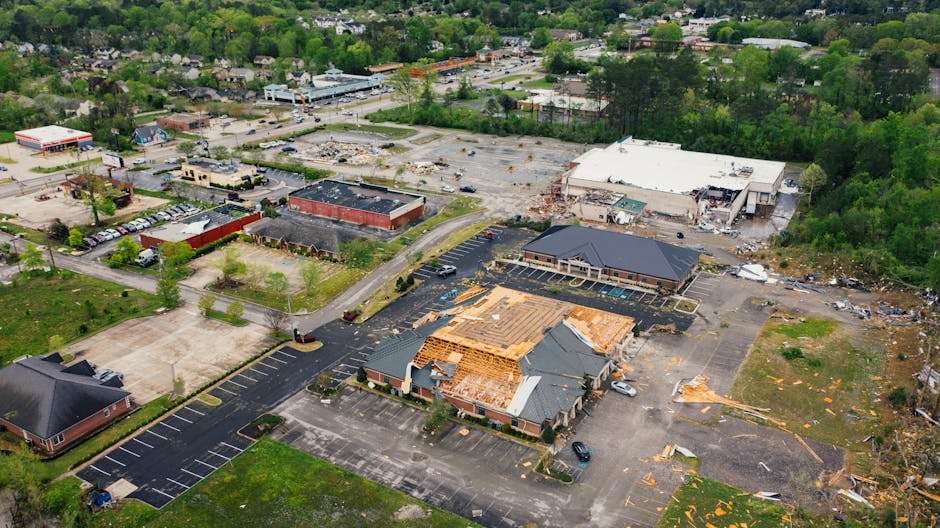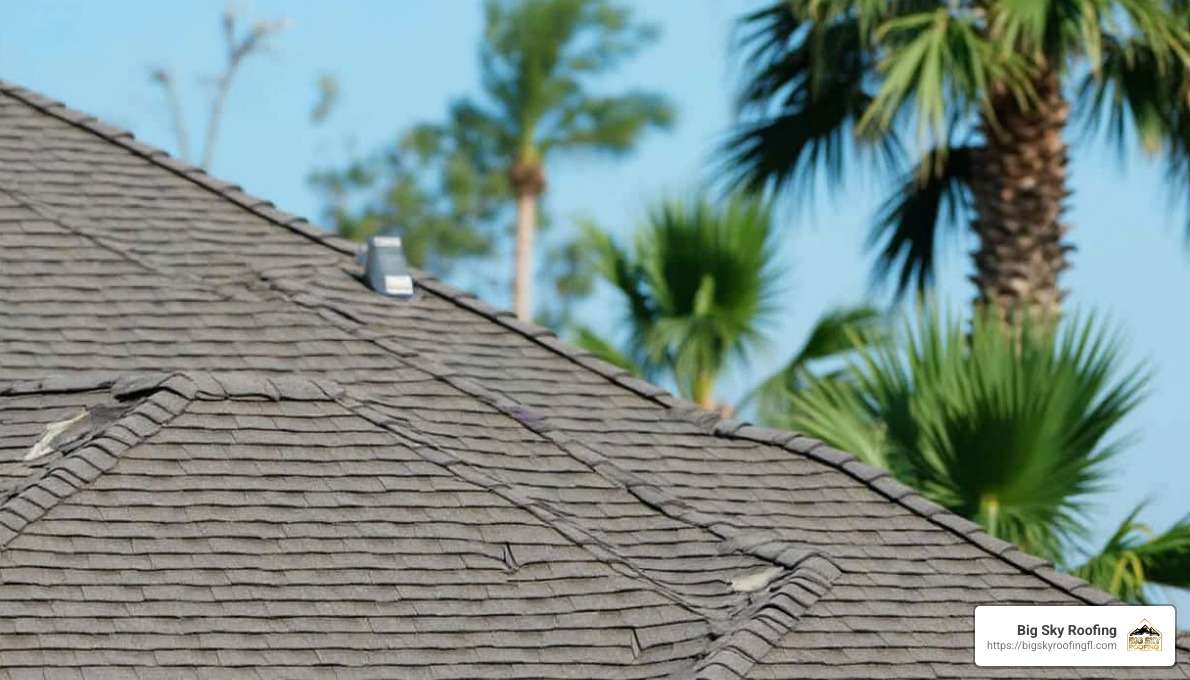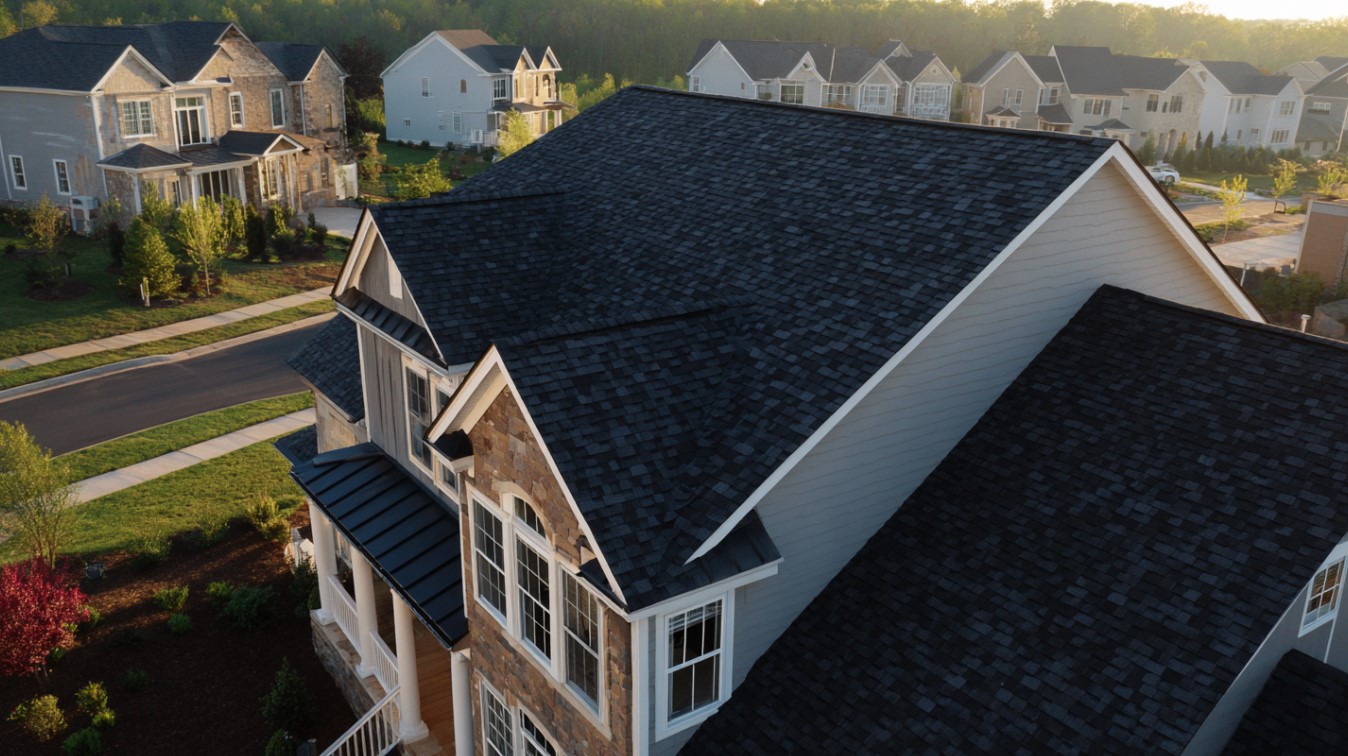Stop Roof Leaks Fast With These Proven Roof Sealants
•
Written By
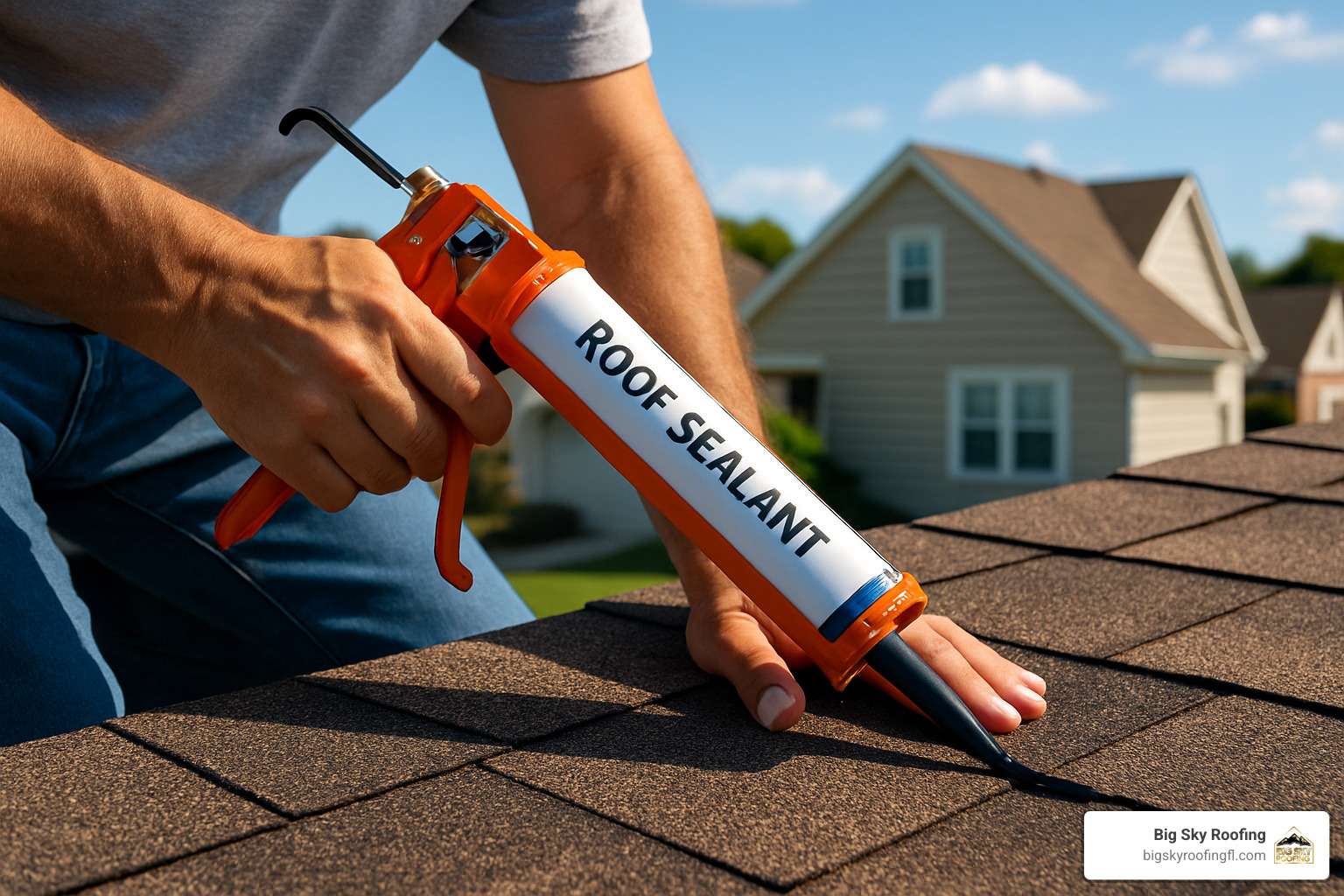
Roof Sealant for Leaks: 5 Powerful Solutions That Stop Damage
Finding the Right Roof Sealant for Your Leak
Roof sealant for leaks is a specialized waterproof coating designed to stop water intrusion through your roof. If you’re experiencing a leak and need quick guidance, here’s what you need to know:
As Florida homeowners know all too well, roof leaks are among the most common household problems. In fact, over 40% of homeowners will experience a roof leak at some point, with repair costs ranging from $300 to $1,100 for professional fixes. The good news? Using the right roof sealant can often resolve minor leaks for under $50.
When water finds its way through your shingles, flashing, or roof seams, it can quickly cause damage to your attic, insulation, ceilings, and walls. Here in Florida’s Sumter, Lake, Citrus, Hernando, Orange, and Marion Counties, our combination of heavy rains and intense UV exposure makes finding durable roof sealants especially important.
The best roof sealant for your leak depends on your specific situation: the roof material, weather conditions, and whether you need an emergency fix or a longer-term solution. Some sealants, like Henry 208R Rubberized Wet Patch, can even stop leaks instantly in standing water and at temperatures as low as 0°F.

Roof sealant for leaks terms to remember:
– minor roof leak repair cost
– roof leak repair
Why Using the Right Roof Sealant for Leaks Matters
Water is one sneaky adversary for Florida homeowners. It can slip through the tiniest cracks in your roof and travel surprising distances through what experts call capillary action. That’s why the leak staining your living room ceiling might actually originate from a completely different area of your roof!
Roof sealant for leaks creates a protective waterproof membrane that stops this water migration in its tracks. But here’s the thing – picking the wrong sealant is like trying to patch a boat with paper towels. You’ll waste money and potentially face even more extensive damage down the road.
“The biggest mistake we see homeowners make in Sumter and Lake Counties is using interior caulk on exterior roof problems,” says our lead technician at Big Sky Roofing. “These products simply aren’t designed to withstand Florida’s brutal UV exposure and those afternoon thunderstorms we all know too well.”
Beyond just stopping annoying drips, quality roof sealants can actually save you money on energy bills. Research shows that reflective white sealants can reduce roof surface temperatures by up to 50°F! For our customers in Orange and Marion Counties, where summer temps regularly soar into the 90s, this translates to significantly lower cooling costs and a more comfortable home.

How Roof Sealants Actually Stop Water
The science behind roof sealant for leaks is pretty fascinating. Quality sealants create what’s called an elastomeric film – basically a rubber-like membrane that tightly hugs your roof surface while remaining flexible. This flexibility is absolutely critical because your roof is constantly expanding and contracting with temperature changes.
“A good roof sealant needs to be like a second skin for your roof,” explains our roofing specialist. “It moves with the roof through heat, cold, and moisture without cracking or separating.”
This elasticity allows the sealant to maintain its waterproof seal even as your roof shifts slightly through Florida’s dramatic seasonal changes. Premium silicone formulations can stretch up to 1000% of their original size without breaking their waterproof bond – imagine a rubber band that can stretch ten times its length while still keeping water out!
For flat or low-slope roofs common throughout Citrus and Hernando Counties, protection against ponding water is particularly important. Standard roofing materials deteriorate when water sits on them for days, but high-quality silicone and rubberized sealants maintain their integrity even when submerged for extended periods.
Can Roof Sealant Replace Full Roof Repair?
This is probably the most common question we hear from homeowners across Central Florida, and the honest answer is: it depends on what’s actually happening with your roof.
Roof sealant for leaks works wonderfully as a temporary patch during emergency situations, a maintenance solution for minor leaks, a preventative measure for vulnerable areas like flashing and seams, and a way to extend the life of an aging but structurally sound roof.
However, sealant isn’t magical – it cannot fix structural issues or replace severely damaged roofing materials. If your roof has rotted decking, multiple layers of damaged shingles, widespread granule loss, structural sagging, or extensive moisture damage to the underlayment, sealant alone simply won’t cut it.
“We always recommend a professional inspection before deciding on sealant versus repair,” notes our Big Sky Roofing project manager. “What looks like a simple leak might be a symptom of a larger problem that sealant can’t fix.”
That’s why, given Florida’s unique climate challenges, we offer free roof inspections to help homeowners make informed decisions about whether sealant is the right solution or if more comprehensive repairs are needed. After all, the goal isn’t just to stop today’s leak – it’s to protect your home for years to come.
5 Top Categories of Roof Sealant for Leaks (Pros, Cons, Best Roof Types)
With thousands of products on the market, choosing the right roof sealant for leaks can feel like navigating a maze. Don’t worry—we’ve simplified your options down to five major categories that work exceptionally well for Florida homes:
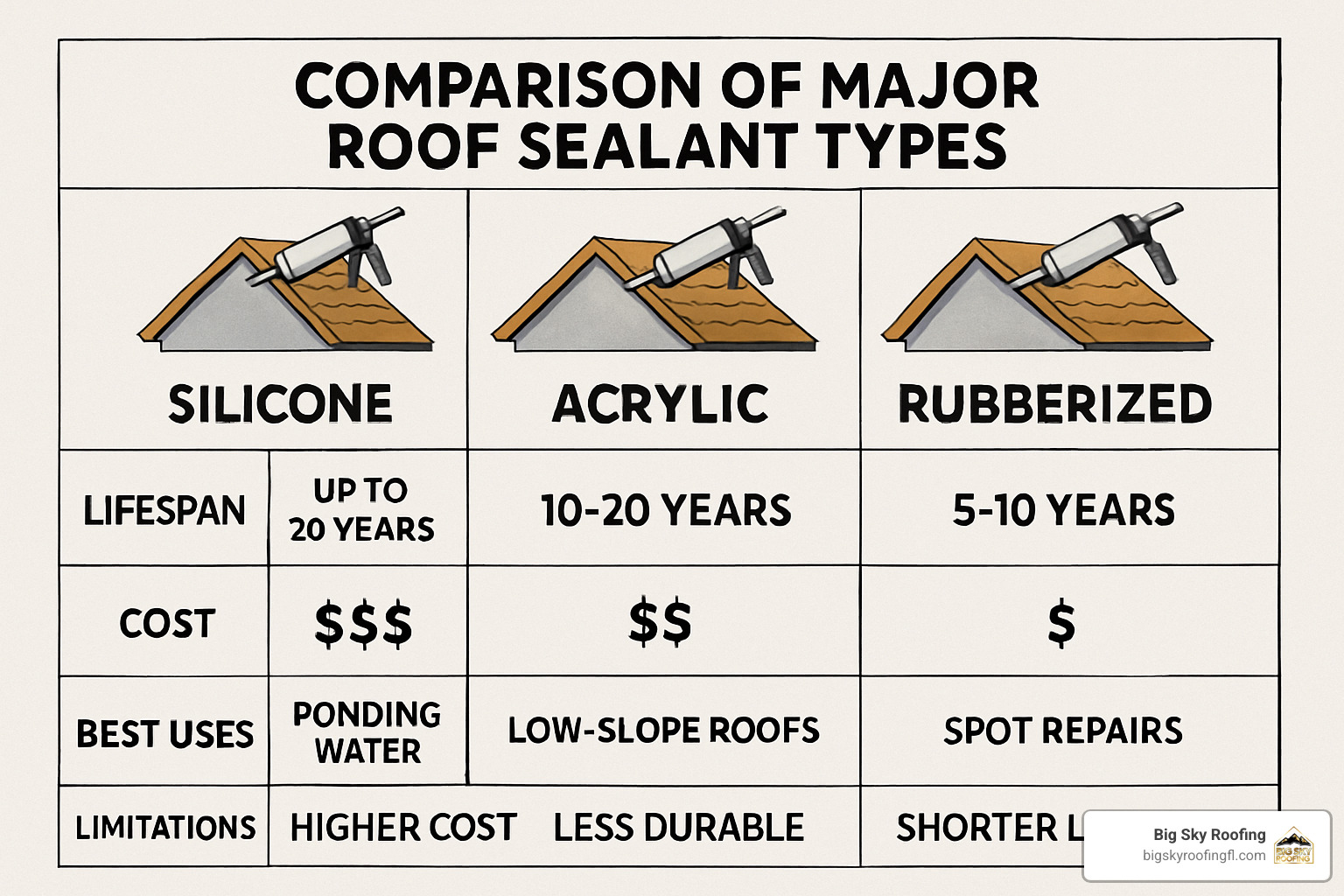
“For homes in Marion and Lake Counties, we typically recommend silicone or acrylic sealants due to their superior UV resistance,” shares our roofing specialist. “The intense Florida sun breaks down lesser sealants much faster, leaving your roof vulnerable sooner than you’d expect.”
When selecting the perfect roof sealant for leaks for your home, there’s more to consider than just price. Coverage rate is crucial—some premium sealants might cost more per gallon but cover twice the area, making them more economical in the long run. In Florida’s unpredictable weather, curing time matters tremendously. Some sealants need 24-48 hours of dry conditions to set properly, which can be challenging during our rainy season in Citrus and Hernando Counties.
Health-conscious homeowners should pay attention to VOC (Volatile Organic Compound) content. Lower VOC sealants not only reduce your environmental footprint but also minimize those strong chemical odors that can linger around your home. The OSHA safety guidelines recommend using sealants with VOC levels under 250 g/L whenever possible, especially for DIY applications where professional-grade ventilation equipment isn’t available.
The application method can make or break your roof sealing project. Spray applications cover large areas quickly but require more skill to apply evenly. Brush-on sealants offer better control for detailed work around vents and chimneys. Trowel-grade products work well for filling deeper cracks, while tape products provide instant sealing for emergencies.
“What works best for a flat commercial roof in Orange County might be completely wrong for a steep-pitched tile roof in Sumter County,” explains our Big Sky Roofing project manager. “That’s why we always assess both the roof type and the specific leak pattern before recommending a sealant category.”
Each of these sealant types has earned its place in our professional toolkit because they all solve specific problems better than others. In the following sections, we’ll dive deeper into each category so you can make the most informed decision for your home’s protection.
1. Silicone Sealants – Best for Standing Water
When facing serious water intrusion problems, silicone-based roof sealant for leaks truly shines above all other options. These premium products create a durable, rubber-like membrane that can handle the toughest Florida weather—even standing water won’t break down these powerful sealants.

What makes silicone so impressive is its incredible versatility in our challenging Florida climate. The blazing sunshine that bakes roofs across Marion and Orange Counties is no match for silicone’s exceptional UV resistance, preventing the cracking and degradation that plagues lesser products. Even more impressive, silicone maintains its flexibility in temperatures ranging from freezing to a scorching 400°F—perfect for those summer heatwaves that hit Citrus County.
“I’ve seen homeowners waste hundreds on cheaper sealants that fail within months,” says our senior technician. “Meanwhile, the silicone we applied to a commercial building in Hernando County has been performing flawlessly for over 12 years—even after taking a direct hit during hurricane season.”
Products like GacoFlex SF2000 SeamSeal and Henry 885 Tropi-Cool have earned stellar reputations among our team. The 100% silicone formulations in white can reflect up to 90% of UV rays, which translates to significantly lower cooling costs—a welcome relief during those sweltering Lake County summers.
The only real downsides? Silicone comes with a higher upfront cost, and it can be quite slippery when wet, making it less than ideal for roof areas you might need to walk on regularly.
Choosing Silicone For Your Roof Type
Silicone roof sealant for leaks works wonders on several common roofing materials we see throughout Central Florida:
Metal roofs benefit tremendously from silicone’s flexibility, especially around those troublesome fasteners and seams that often leak first. As metal expands and contracts dramatically with temperature changes, silicone moves right along with it without breaking its watertight seal.
Flat and low-slope roofs—common on commercial buildings throughout Hernando County—perform exceptionally well with silicone coatings because of their best resistance to ponding water. Where other sealants might deteriorate after just 72 hours underwater, quality silicone formulations remain intact indefinitely.
EPDM rubber roofing, aging modified bitumen surfaces, and those tricky skylight flashings all respond beautifully to silicone applications. In Sumter County’s humid climate, where afternoon thunderstorms are a way of life, silicone provides superior protection against moisture intrusion.
Here’s a helpful application tip from our team: When sealing around skylights or any roof penetration, always extend your silicone sealant at least 4 inches onto the surrounding roof surface. This creates what we call a “waterproof collar” that prevents water from sneaking underneath the sealed area—a common mistake we see in DIY repairs across Marion County.
2. Acrylic Elastomeric Sealants – Reflective & Budget-Friendly
Looking for that sweet spot between performance and affordability? Acrylic elastomeric roof sealant for leaks hits the bullseye for many Florida homeowners. These water-based formulations have become the darling of Central Florida roofing for good reason – they reflect heat beautifully while being gentler on your wallet.

When summer temperatures in Lake County climb into the 90s, these sealants really shine – literally! The white acrylic formulations can reflect up to 85% of the sun’s rays, creating what industry folks call a “cool roof.” This remarkable reflectivity can slash your cooling costs by 15-30%, which explains why many Florida utility companies offer rebates when you coat your roof with these products.
“I’ve had customers call me in amazement after their first electric bill following an acrylic coating,” says our senior technician. “One Hernando County family saved almost $70 in July alone compared to the previous year.”
Products like Henry 289 Elastomeric White Roofing Sealant have earned impressive 4.5-out-of-5 ratings from hundreds of customers. Homeowners love the relatively low odor during application and the simple water cleanup – no harsh chemicals needed.
Acrylic sealants form a perfect partnership with several roof types. They adhere beautifully to asphalt shingles, concrete or clay tiles, and previously coated surfaces. The flexibility of acrylic allows it to expand and contract with your roof as temperatures fluctuate through our hot days and cooler nights.
There are a couple of limitations worth noting. Unlike their silicone cousins, acrylics must be applied to completely dry surfaces – no exceptions. They’re also not suitable for areas where water tends to pond. And patience is required during curing – typically 24-48 hours of dry weather after application. In rainy season, this can require some planning!
When Acrylic Outperforms Other Roof Sealant for Leaks
The relentless Florida sunshine that bathes Citrus County makes acrylic roof sealant for leaks a standout performer here. The science backs this up – we’ve measured dark shingle roofs in the height of summer exceeding a scorching 160°F. Apply a quality white acrylic coating, and those same surfaces cool dramatically to around 110°F.
“That 50-degree difference isn’t just about comfort,” explains our energy efficiency specialist. “It directly extends the life of your roofing materials by reducing thermal shock and UV degradation.”
Acrylic sealants also win points for being environmentally friendly with their low VOC content. Your neighbors (and your lungs) will appreciate the reduced chemical emissions during application.
Perhaps one of the most underrated benefits is acrylic’s breathability. Unlike some sealants that trap moisture, acrylic allows tiny amounts of water vapor to escape, which helps prevent bubbling and blistering over time – a significant advantage in Marion County’s humidity.
Application is remarkably user-friendly – you can roll it, brush it, or spray it on. And when the time comes for maintenance, usually every 5-7 years in our Florida climate, you’ll appreciate how new layers bond seamlessly with old ones. Each reapplication actually strengthens your waterproofing protection rather than requiring removal of the old material.
For Orange County homeowners seeking a balance of performance, price, and planet-friendliness, acrylic elastomeric sealants offer compelling value that’s hard to beat.
3. Rubberized Wet-Patch Sealants – Emergency Repairs
When the skies open up during a fierce Florida thunderstorm and water starts dripping through your ceiling, rubberized wet-patch roof sealant for leaks becomes your knight in shining armor. Unlike other sealants that require bone-dry conditions, these specialized formulations can be applied while rain is actually falling – a true lifesaver during our unpredictable storm seasons.
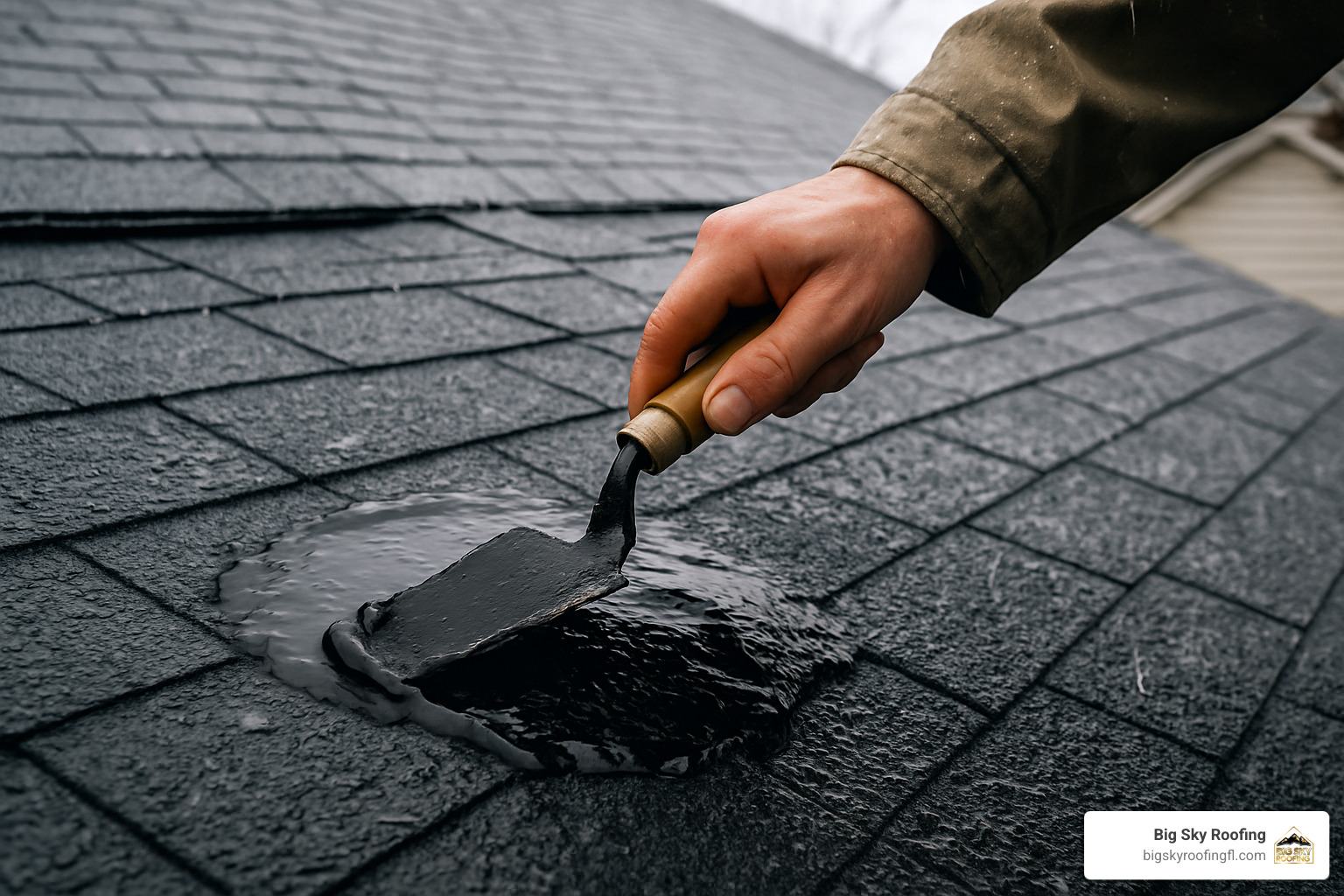
“I’ll never forget helping an elderly couple in Orange County during Hurricane Irma,” shares our emergency response team leader. “Water was pouring through their kitchen ceiling, but we applied Henry 208R Rubberized Wet Patch right through the driving rain. The relief on their faces when the dripping stopped was worth every minute in that storm.”
What makes these products truly remarkable is their versatility in extreme conditions. They can adhere to soaking wet surfaces, work in temperatures from freezing to scorching (0°F to 120°F), and bond to virtually any roofing material. The thick, trowel-grade consistency creates an immediate seal that stops water intrusion on contact.
These emergency heroes excel particularly around troublesome areas like chimney bases, where the meeting of different materials often creates vulnerable points. In Hernando County, where afternoon thunderstorms can appear seemingly out of nowhere, keeping a bucket of rubberized wet-patch in your garage can mean the difference between a minor inconvenience and thousands in water damage.
The trade-off for this emergency capability is longevity. While premium silicone sealants might last a decade or more, rubberized wet-patch typically provides 3-5 years of protection. But when water is actively streaming into your living room, that immediate protection is priceless.
For best results, our Big Sky Roofing technicians recommend removing as much standing water as possible with a shop vacuum or even a squeegee before application. Then apply the sealant generously with a trowel, extending at least 3 inches beyond the damaged area in all directions. The thick, rubber-like consistency might seem challenging to work with at first, but that density is precisely what allows it to displace water and create an immediate bond.
“Think of rubberized wet-patch as your roofing first-aid kit,” our Marion County team supervisor explains. “It might not be the permanent solution, but it stops the bleeding until proper medical attention—or in this case, comprehensive roof repair—can be performed.”
4. Butyl Tape & Caulk – Sealing Seams and Fasteners
When you’re dealing with those pesky seams, joints, and fasteners that just won’t stop leaking, butyl-based roof sealant for leaks might be your perfect solution. It’s like the unsung hero of the roofing world – not as flashy as whole-roof coatings, but incredibly effective where it counts.
Butyl sealants come in two main forms: tape and caulk. Both create a remarkably watertight seal that stays flexible through Florida’s extreme temperature swings. This flexibility is crucial – your roof is constantly expanding and contracting with the weather, and your sealant needs to move with it.
“I’ve seen butyl tape still holding strong on metal roofs in Lake County after 8 years of Florida sun and storms,” shares our senior technician. “What makes it special is how it bonds to those tricky metal surfaces that other sealants just slide right off of.”
The magic of butyl is in its targeted application. While it’s not meant to cover your entire roof, it excels at sealing the specific vulnerable points where water tends to find its way in. Metal roof seams, the area around fasteners and screws, RV roof joints, and spots where wind-driven rain sneaks past other barriers are all perfect candidates for butyl treatment.
Products like EternaBond RoofSeal tape have developed quite a following among Florida homeowners for good reason. This remarkable tape can stretch up to 700% of its original size without breaking its seal. For DIYers, the peel-and-stick application eliminates the mess and guesswork of liquid sealants.
Our mobile home specialist has seen how effective butyl can be: “For manufactured homes across Marion County, butyl tape has become our first choice for seam repairs. Even when temperatures hit the high 90s, it doesn’t melt or degrade, and it stays just as flexible during those January cold snaps.”
When applying butyl tape to your roof, here’s a pro tip: after placing the tape over a metal roof seam, use a roller tool to firmly press it into place. This pressure activation ensures complete contact with both sides of the seam, maximizing the adhesive bond and creating a truly watertight seal.
While butyl might not be suitable for covering large areas, its best ability to bond to difficult surfaces makes it an essential part of any roof repair toolkit. For those troublesome metal roofs throughout Citrus and Hernando Counties, butyl often provides the lasting seal that other products simply can’t match.
5. Polyurethane Foam Sealants – Filling Large Gaps
When dealing with significant gaps, separations, or areas requiring both sealing and insulation, polyurethane foam roof sealant for leaks provides a unique solution. These expanding foam products fill voids while creating a waterproof barrier.
Polyurethane foam sealants are ideal for:
– Sealing larger gaps around roof penetrations
– Filling spaces between roof and wall connections
– Insulating while waterproofing (improving energy efficiency)
– Creating custom-shaped seals around irregular features
– Stopping air infiltration along with water leaks
The spray polyurethane foam (SPF) expands after application to fill voids completely, creating a seamless barrier against water intrusion. For Orange County homes built to modern energy codes, these products help maintain building envelope integrity.
“We’ve used polyurethane foam successfully around new skylight installations where the framing created irregular gaps,” shares our installation team leader. “The foam expands to fill all spaces, then can be trimmed and sealed with a top coating for UV protection.”
The main considerations with polyurethane foam are the need for dry conditions during application and the requirement for UV protective coating if exposed to sunlight. Most foam sealants will degrade within months if left exposed to Florida’s intense sun.
Step-by-Step Guide: Applying Roof Sealant Safely
Rolling up your sleeves to tackle a roof leak? Smart move! Applying roof sealant for leaks correctly isn’t just about slapping some product on the problem area—it’s about doing it right the first time so you’re not back up there next month doing it again.
Let’s walk through how to handle this job safely and effectively:
Safety should always come first when you’re working at height. Before you even think about opening that sealant container, make sure your ladder is on stable ground and secured properly. Wear those non-slip shoes (your regular flip-flops won’t cut it here in Florida!), and for steeper roofs, consider using a safety harness. And please—no matter how small the repair—never climb up during thunderstorms or when those afternoon winds kick up.
“I can’t tell you how many times we’ve been called to rescue a homeowner who got stuck on their roof during a sudden Florida downpour,” says our safety coordinator. “Those metal roofs become like slip-n-slides when wet!”
Proper surface preparation makes all the difference in how long your repair will last. Think of it like painting your nails—skip the base coat, and that polish chips right off. Take time to thoroughly remove all debris, dirt, and any loose material from the repair area. Most sealants require a clean, dry surface to properly bond.
Finding the true source of your leak might take some detective work. Water is sneaky—it can enter your roof in one spot but travel along rafters or decking before showing up inside your home. Our Marion County team recently helped a homeowner who had been sealing the wrong area for months because the water was traveling nearly 10 feet from its entry point!
Each type of sealant calls for specific application tools. For silicone or acrylic coatings, you’ll need a brush, roller, or trowel depending on the area size. Rubberized sealants work best with a trowel or putty knife for pushing the material into cracks. When using butyl tape, a roller helps activate the adhesive with proper pressure. And polyurethane foam requires its special applicator gun for controlled expansion.
Always follow manufacturer directions closely. Pay special attention to:
– The recommended application temperature (applying in extreme heat or cold can prevent proper curing)
– Required thickness (measured in “mils”—usually you’ll need more than you think)
– Proper drying time between coats if multiple applications are needed
– Whether the product is compatible with your specific roof material
“The most common application mistake we see throughout Lake County is insufficient coverage,” explains our repair specialist. “Homeowners often spread the sealant too thin trying to make it go further. Unfortunately, this leads to premature failure and more leaks down the road.”
When applying the sealant, don’t just cover the visible damage. Extend your application at least 2-3 inches beyond the problem area in all directions. This creates a proper waterproof seal that prevents water from working its way under the edges of your repair.
Finally, respect the curing time. Yes, it’s tempting to test your repair by spraying it with a hose right away, but most sealants need 24-72 hours to fully cure. Even “fast-setting” products need some time to reach their full waterproofing potential.
Can You Seal a Roof in the Rain?
Living in Florida means sometimes you can’t wait for perfect weather to fix that leak. Whether you can apply sealant during wet conditions depends entirely on what product you’re using:
Rubberized wet-patch sealants are your rainy-day heroes. These specialized formulas are specifically engineered for wet conditions and can even be applied during light rainfall or in standing water. They’re the go-to solution for emergency repairs during our notorious summer thunderstorms.
Many (but not all) silicone sealants can handle damp surfaces, though you should remove standing water first. Always check the specific product’s documentation to be sure before application.
For acrylic, butyl, and polyurethane sealants, the answer is generally no—these require dry conditions to properly adhere and cure. Applying these in wet conditions is usually just wasting your time and money.
“During hurricane season in Sumter County, we keep emergency wet-patch sealants on hand specifically for these situations,” shares our storm response team leader. “They provide immediate protection until more permanent repairs can be made when dry weather returns.”
If you’re facing an active leak during rain and don’t have wet-patch sealant on hand, focus on damage control: place buckets to catch interior drips, cover the affected exterior area with a tarp if possible, and call us for professional help when conditions improve.
Common Mistakes DIYers Make
Even the most enthusiastic DIYers can fall prey to these common roof sealant for leaks mistakes:
Poor surface preparation tops the list of reasons sealants fail prematurely. That rush to fix the problem often means skipping proper cleaning. Take the extra 15 minutes to remove all dirt, loose materials, and old deteriorated sealant—your future self will thank you.
Using the wrong product for the job happens more often than you’d think. Interior caulk might look similar to roof sealant, but it’s not designed to withstand Florida’s harsh UV exposure and heavy rains. That bargain caulk might seem like a money-saver now, but you’ll pay more later when it fails within months.
Over-diluting sealants is tempting when trying to make products go further, but excessive thinning seriously compromises waterproofing ability. Follow the manufacturer’s recommendations exactly—they’ve engineered the product for specific viscosity.
“We recently helped a Citrus County homeowner who had applied three different sealants to his roof—all in the wrong location,” our inspection specialist recalls with a smile. “Water was entering around a vent pipe but showing up 15 feet away inside the house. Proper inspection identified the true source.”
Insufficient thickness is another common error. Most liquid sealants require specific mil thickness (often 30-50 mils) to provide proper waterproofing. Thin applications might look good initially but will fail quickly under Florida’s harsh conditions.
Don’t forget about weather conditions when planning your repair. Applying temperature-sensitive sealants during extreme heat can prevent proper curing. In Orange County’s summer heat, roof surface temperatures can exceed 150°F, well beyond the application range of many products.
Neglecting flashing and penetrations means missing the most common leak sources. Vents, chimneys, skylights, and other roof penetrations account for nearly 90% of all roof leaks. These areas require special attention with appropriate sealant.
The right repair done properly can save you thousands in potential water damage. When in doubt, our team at Big Sky Roofing is always available for a free inspection to help identify the true source of your leak and recommend the best solution.
How Much Roof Sealant Do You Need & What Will It Cost?
Figuring out how much roof sealant for leaks you’ll need doesn’t have to be complicated, but getting it right saves both money and headaches. Nothing’s worse than being halfway through your repair when you realize you’re running short!
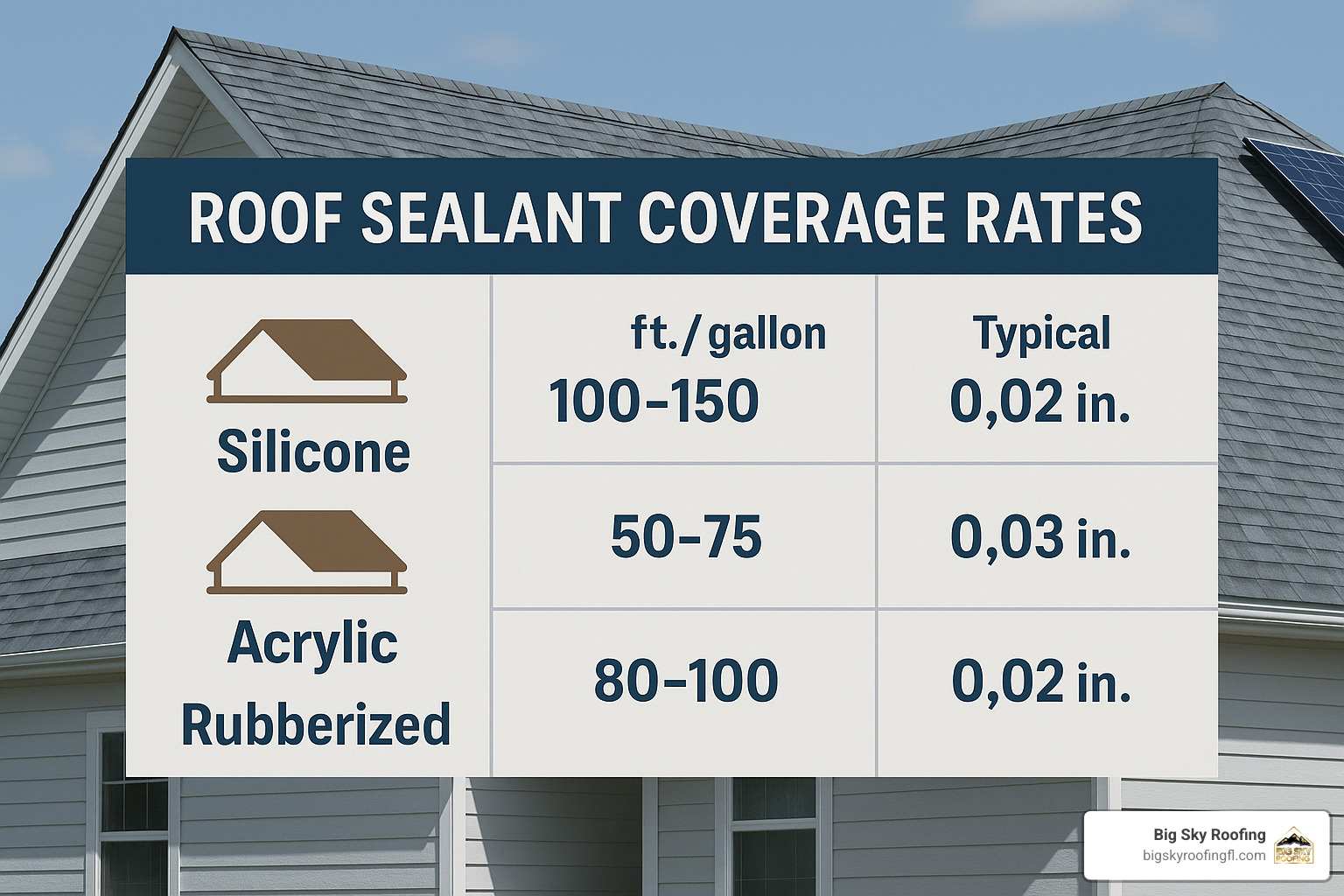
“Most folks I talk to in Lake County tend to underestimate how much product they’ll need,” shares our Big Sky materials coordinator. “The coverage rates on product labels often assume ideal conditions and perfect surfaces—and let’s be honest, when do we ever have those in Florida?”
Each type of sealant comes with different coverage expectations and price points. Silicone sealants, while pricier at $30-$100 per gallon, cover about 50-100 square feet and last the longest. Our budget-friendly acrylic options run $20-$50 per gallon with similar coverage. Rubberized wet-patch products are applied much thicker, so they only cover 12-25 square feet per gallon at their recommended 1/8″ thickness.
For targeted repairs around flashings or small penetrations, butyl tape is wonderfully efficient—a 50-foot roll covers exactly that, 50 linear feet of seams or cracks. Polyurethane foam is trickier to calculate since it expands after application, but a standard can handles several smaller gaps or one medium-sized void.
When deciding between container sizes, think about your specific project:
Single small leak repair? A 10-ounce caulk tube (covering about 25 linear feet with a 1/4″ bead) or quart container might be perfect.
Several trouble spots? A gallon container makes more sense both practically and financially.
Full roof coating? You’ll need to calculate your roof’s square footage carefully—measure length × width and add 15% for slopes and overlaps.
“I always tell our Marion County customers to buy a little extra,” our project manager explains with a smile. “Leftover quality sealant stores well for future touch-ups, but running out mid-job can mean your repair sits exposed overnight—right when that surprise Florida thunderstorm rolls in!”
According to recent research on retail pricing, buying in bulk can save up to 40% per ounce compared to smaller containers. For Citrus County homeowners tackling larger projects, five-gallon buckets of premium sealant might seem expensive upfront at $150-$400, but the per-square-foot cost drops significantly.
The true value calculation goes beyond just the initial price tag. A premium silicone sealant at $75 that lasts a decade in Orange County’s intense UV exposure is ultimately much cheaper than reapplying a $25 economy product every two years. When you factor in your time and effort, sometimes spending a bit more upfront makes all the difference.
Proper application thickness is crucial—skimping to stretch your product further almost always leads to premature failure. Those manufacturer specifications for mil thickness (typically 15-25 mils for liquid sealants) aren’t suggestions; they’re requirements for proper waterproofing performance.
“The most expensive sealant,” as our Sumter County team likes to say, “is the one that doesn’t work.”
Maintenance Tips After Sealing to Prevent Future Leaks
Congratulations on applying roof sealant for leaks to protect your home! Now let’s make sure your hard work continues paying off for years to come. Just like any good investment, a little ongoing care goes a long way.
In our experience helping homeowners across Central Florida, we’ve found that a well-maintained sealant job can often exceed the manufacturer’s expected lifespan. The secret? Regular attention and a few simple habits.
“I tell my customers in Lake County that their roof is like a classic car—a little TLC keeps it looking great and functioning perfectly,” shares our maintenance team leader. “Five minutes of inspection each month can save thousands in potential water damage.”
Start by marking your calendar for an annual roof check-up, ideally before the heavy rains arrive in June. Florida’s rainy season can be merciless, and you’ll want to know your seals are ready to perform when those afternoon thunderstorms roll through Marion County.
Debris is your sealant’s worst enemy. Those oak leaves, pine needles, and palm fronds that accumulate in valleys and corners trap moisture against your roof surface. This creates the perfect environment for premature sealant breakdown, especially in humid areas like Citrus County. A simple cleaning with a leaf blower (from the ground or a safely positioned ladder) can add years to your sealant’s life.
Don’t forget about those beautiful shade trees! While they help keep your home cooler, overhanging branches can damage your roof during storms. In Hernando County, where summer thunderstorms often bring strong winds, we recommend trimming branches that extend over your roof. This simple step prevents both impact damage and reduces the amount of debris that lands on your roof.
After major weather events—particularly during hurricane season—take a few minutes to check your roof from the ground with binoculars. Look for any obvious new damage that might have compromised your sealed areas. Early detection of problems allows for small, inexpensive fixes rather than major repairs.
Florida’s sunshine is wonderful for your tan but brutal on building materials. In Orange County’s intense UV exposure, even premium sealants will eventually show signs of aging. Watch for these warning signs that it’s time for reapplication:
- Cracking or alligatoring of the sealant surface
- Chalky residue when you touch the sealant
- Peeling or separation from the roof surface
- Discoloration (especially darkening of light-colored sealants)
Different sealants have different lifespans in our Florida climate. Silicone typically lasts 10-20 years, while acrylic needs refreshing every 5-7 years. Rubberized wet-patch products generally need attention every 3-5 years, and butyl products typically perform well for 7-10 years before requiring reapplication.
“One tip we share with our Sumter County customers is to take dated photos when sealant work is first completed,” explains our customer service manager. “These images provide an excellent baseline for comparison during future ins

